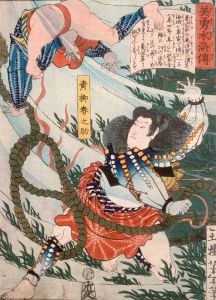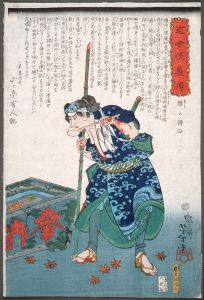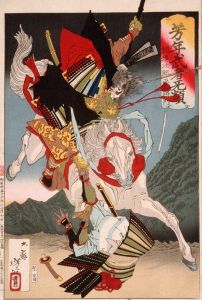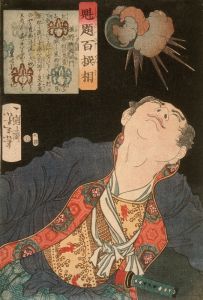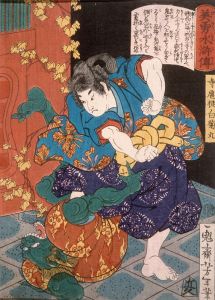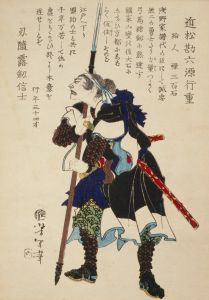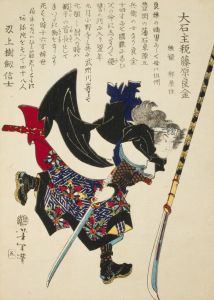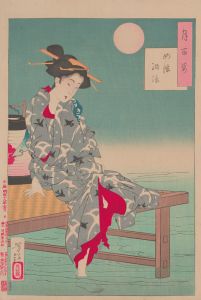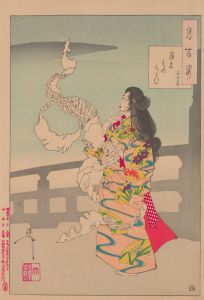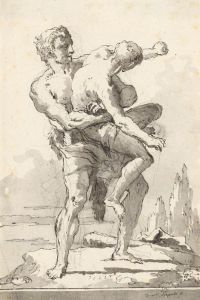
Nomi no Sukune Wrestling with Taima no Kehaya
A hand-painted replica of Tsukioka Yoshitoshi’s masterpiece Nomi no Sukune Wrestling with Taima no Kehaya, meticulously crafted by professional artists to capture the true essence of the original. Each piece is created with museum-quality canvas and rare mineral pigments, carefully painted by experienced artists with delicate brushstrokes and rich, layered colors to perfectly recreate the texture of the original artwork. Unlike machine-printed reproductions, this hand-painted version brings the painting to life, infused with the artist’s emotions and skill in every stroke. Whether for personal collection or home decoration, it instantly elevates the artistic atmosphere of any space.
"Nomi no Sukune Wrestling with Taima no Kehaya" is a woodblock print by the renowned Japanese artist Tsukioka Yoshitoshi, created in the late 19th century. Yoshitoshi, a master of the ukiyo-e genre, is celebrated for his innovative approach to traditional Japanese themes and his ability to capture dynamic movement and emotion in his works. This particular print is part of Yoshitoshi's series "Tsuki hyakushi" (One Hundred Aspects of the Moon), which he produced between 1885 and 1892. The series is known for its exploration of historical, mythological, and literary subjects, all unified by the motif of the moon.
The print depicts a legendary wrestling match between Nomi no Sukune and Taima no Kehaya, figures from ancient Japanese lore. This story is significant in Japanese culture as it is often cited as the origin of sumo wrestling. According to historical accounts, particularly the "Nihon Shoki" (Chronicles of Japan), which is one of the oldest records of Japanese history, this event took place during the reign of Emperor Suinin, around the 1st century AD.
Nomi no Sukune is celebrated as a legendary hero and is often credited as the progenitor of sumo wrestling. He was summoned by Emperor Suinin to challenge Taima no Kehaya, a formidable wrestler who boasted of his strength and claimed that no one could defeat him. The match was held in the presence of the emperor, and it was a fight to the death. Nomi no Sukune emerged victorious by employing a series of grappling techniques, which are considered the precursors to modern sumo moves. This victory not only established Nomi no Sukune's legacy but also laid the foundation for sumo as a structured sport in Japan.
Yoshitoshi's depiction of this legendary match captures the intensity and drama of the encounter. His use of bold lines and dynamic composition conveys the physicality and tension of the wrestling bout. The print is notable for its attention to detail, from the expressions of the wrestlers to the intricate patterns on their clothing, which reflect Yoshitoshi's skill and dedication to his craft.
This artwork is a testament to Yoshitoshi's ability to blend historical narrative with artistic expression, making it a valuable piece for both art enthusiasts and those interested in Japanese cultural history. The "Tsuki hyakushi" series, including this print, is considered one of Yoshitoshi's masterpieces and represents a significant contribution to the ukiyo-e tradition, capturing the imagination of audiences both in Japan and internationally.
In summary, "Nomi no Sukune Wrestling with Taima no Kehaya" by Tsukioka Yoshitoshi is a culturally and historically significant work that illustrates a foundational myth of sumo wrestling, rendered with the artist's characteristic skill and attention to detail.





